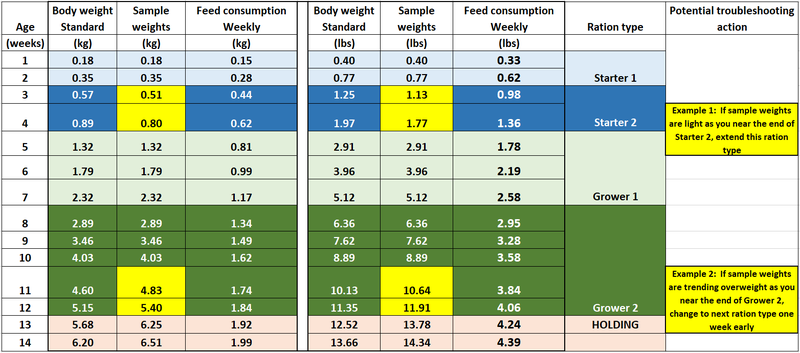
Published on Jan. 2, 2020
Enhance egg production through weight management
In order to optimize egg production, focusing on weight profiles is one area of importance that is often overlooked. Body weight sampling and managing the correct standard at each stage of growth will help your breeders produce a high number of good quality eggs.
Weight profiles and feeding program
Weight profiles and feeding programs play an important role in breeder performance, especially during rearing. Heavier birds and reproduction are negatively correlated. This presents a challenge given the demand for producing a heavier bird for the processing plants. Breeders should follow the recommended parent stock body weight, growth curve, and diet proposed by their genetic providers in order to achieve the full genetic potential of their flock.
Sampling procedures to obtain body weights
The following method is recommended to ensure that body weight samples are representative of actual flock values:
- Walk through the barn to encourage mixing of the flock prior to sampling. Pay special attention to move birds away from the walls and corners of the building.
- Use a weigh scale that is accurate to at least 0.2 kg (0.5 lbs). More accurate measures will be obtained with a more sensitive scale.
- Sample birds at random from several locations in the barn.
- When possible, use a small catch pen to corral birds and record weights of all birds in the pen to ensure random sampling.
- Weigh at least 1% of the flock or a minimum of 50 birds.
With the data collected, you can determine the sample average and compare it to the recommended standards to see if your flock is growing according to the breeder recommendations. Frequent body weight sampling and quick reaction with management changes is critical to ensuring optimal flock weights.
Managing body weight deviations
To troubleshoot body weight deviations from the recommended standards, growers should measure flock growth and understand the correlation to various diets. Adjustments to diet durations can be made if you find your flock weights are not in line with the recommended standards.
For example, if you are noticing that your birds are trending underweight, you can extend the diet you are currently using until you reach the next milestone. If the birds are trending overweight, change to the next diet earlier in order to manage weight gain.
The best practice is to follow diets to the desired weights not solely based on the general diet timeline.

Example of how to troubleshoot flock performance
Summary
Focusing on weight and feed management, especially in the rearing phase, will put you on the right path to optimizing egg production. In addition to understanding where your flock is trending along the growth curve, it is important to know the distribution of weights within the flock. For best results, the rule of thumb is to have more than 90% of your birds within approximately 10% of the average sample weight.
Beyond weight and feed, managing parent stock birds involves many other areas of focus including lighting, nest training, and egg handling
Visit our resources section to learn more

